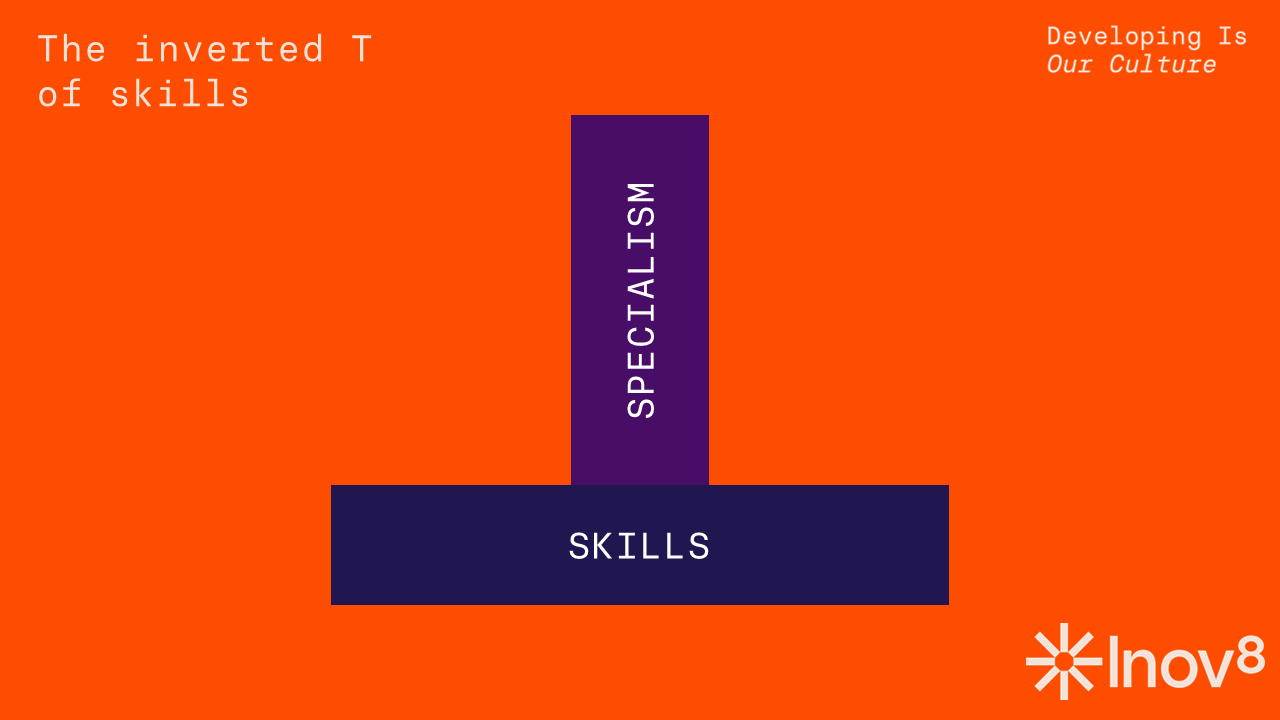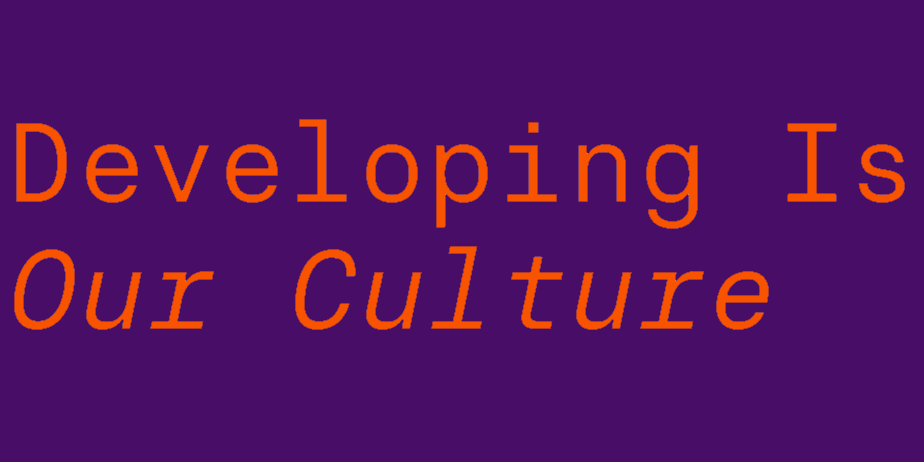10 September 2024
T for Tuesdays - Training
Last week we wrote about Talent. We discussed the capacity of people and providing an environment for continuous improvement and development. It’s only natural that we follow this with Training.
“Earlier this year, I was at a discussion about learning in technology. Many of the speakers were from big corporates, where there was a luxury of highly structured and supportive learning programmes. Many of the audience were not from such companies, so I think there was a disconnect between what was said and what is achievable for most.” Calum Mather, Inov8 GM |
At Inov8, we often talk about "Developing Is Our Culture". Our ethos is to provide a structured and nurturing environment for our people to developing their skills through training. This extends to our clients through the training courses we provide, the high quality of people we provide, and through our Gradu8 trainee scheme.
However, we know not everyone has this kind of culture and structure, so we're here to provide help, advice and support to you!
Let’s take it back to basics and provide some structure to your training. Here are 8 steps to support your learning -
- You want to learn
- Know what to learn
- Know how to learn
- Apply what you learn
- Measure your progress
- Stay motivated and persistent
- Leverage your skills for career or business growth
- Expand and diversify your skill set
1. You want to learn
It might seem a strange thing to say, but motivation is incredibly important when it comes to any learning. With the right motivation you are more likely to absorb information than you would otherwise, which is why having a growth mindset is incredibly important.
I’m not going to cover all the reasons for learning, as this would become a very long blog. Overall, I think we categorise as personal development or business requirements.
2. Know what to learn
If you have a business need, then there’s a good chance you’ll have a clear understanding of the work required. (If you don’t know, then reach out to your friendly data and cloud experts at Inov8.)
If you have a personal requirement to expand your knowledge, then have research the current industry trends. Keep up with industry news, updates, and emerging trends to identify the most relevant skills. Identify in-demand skills by researching what is currently in high demand in the job market or within your industry.
If you have an idea of career goals, then choose skills that align with them and any potential future job roles.
That’s a lot of “ifs”, so seek advice from industry experts, mentors, or peers to understand which skills are worth investing time in.
Lastly, focus on high-impact areas that offer the best return on investment for your career or business.
3. Know how to learn
You’ve now got the motivation and the topics, but do you know how to learn? This is perhaps the most challenging stage of the 8, as everyone is different, and learns in different ways. What works for one person, may not suit another.
The first step is to identify learning resources. Research through online courses, tutorials, and books, to learn a new tech skill. Consider different learning tracks that provide multiple stages towards certification, even if you’re not going to take the exam itself.
By breaking down complex concepts, you can deconstruct topics into manageable bite size chunks, making them easier to understand, digest and learn incrementally.
Document your learning plan and set clear goals.
Take a SMART approach -
Specific, Measurable, Achievable, Relevant, and Time-bound goals.
Stay consistent, by setting aside a portion of time each week or month for learning. It may be your employer will support this and supply that time during the working week, so don’t be scared to ask! Remember that regular and consistent efforts are key to learning new technology.
If you’re stuck, look for a mentor. That may be someone already in your company, your group of friends or someone else in the industry.
4. Apply what you learn
It’s important to reinforce what you learn with practical work. Theoretical work will only get you so far.
“I’ve interviewed a few people who have learned enough to answer a question in a certification exam, but don’t know how to practically apply the knowledge. All the gear and no idea!” – Calum Mather, GM
Create personal or professional projects to apply your new skills and reinforce your understanding. Use your new skills to address real-world challenges or improve existing processes and workflows.
Learn from peer reviews, and get practical experience. Explain concepts to others, write blog posts, or create tutorials, which helps to solidify your own understanding, and forces you to ensure you maintain a high quality of work.
Try new things, explore creative solutions, and innovate by combining new technologies in unique ways. Be prepared to push the boundaries.
5. Measure your progress
This is where the big corporates that I mentioned earlier have got it right. Track learning milestones so that you regularly assess your progress against your goals.
If you can, set benchmarks and use metrics (like completing coding challenges, achieving certifications, or mastering specific tools) to measure your proficiency. However, always remember that people learn at a different pace to each other, so don’t be tough on yourself if you miss those targets slightly!
Periodically evaluate your understanding of what you have been learning through online assessments, quizzes, or colleague/peer feedback.
Adapt your learning strategies based on what’s working and what isn’t, ensuring continuous improvement. The way you start learning may not be the way you finish. Don’t be scared to change strategies, as sometimes the course content fails and it’s not you!
Ask for feedback from those around you, as they will often be the best judges of what you have achieved.
Celebrate achievements by celebrating wins and achievements, no matter how big or smaller, to stay motivated and encourage further learning. By doing this you may also encourage people and be an example to others.
6. Stay motivated and persistent
We’re back to talking about motivation, but with a clear purpose and clear goals, you’ll get there. So take note of why you want to learn the new skill, and remind yourself regularly, keeping you motivated over time.
You will encounter setbacks. C’est la vie! Setbacks are a part of any learning process, so you need to stay resilient when facing difficulties.
It’s important to recognise that what works for one person will not necessarily work for another. Each individual will start from a different point, learn in a different way and at different speeds. Add in the company they work for, the training structure that is in place, the time they are allotted and the support they receive, and there are a great number of variables.
You should surround yourself with supportive peers, mentors, and communities that encourage and guide you.
Maintain a healthy balance between learning, work, and rest to avoid burnout.
Remain flexible and open to changing your learning path as new interests or industry demands emerge. Being able to pivot quickly is a skill in itself.
7. Leverage your skills for career or business growth
Consider obtaining relevant certifications to validate your skills and increase your credibility within your organisation.
You can use your new skills to qualify for higher-level positions, switch careers, or take on more responsibilities at work. It doesn’t always mean moving to a new employer!
8. Expand and diversify your skill set
We’ll talk about the inverted T of skills in a future blog. In the meantime, stay curious and open-minded. Remain open to growing your knowledge on your current knowledge, and/or learn complementary skills that enhance your current areas of expertise.
Combine multiple skills to create a unique value proposition, such as merging tech with business skills. Those business skills will help you apply technical skills in the workplace.
Explore skills outside of your core expertise to broaden your capabilities, and to help understand the impact your work may have on other parts of a larger programme of works. For example, if you are a data engineer, an understanding of data science could help you understand the challenges and requirements data scientists may experience.
Keep yourself up to date with emerging trends and new technologies. This should ensure your skills remains relevant and in demand.
Sit down with your line manage regularly, and assess which skills will benefit you most next and develop a learning roadmap to stay ahead in your field.

Your next steps in Training
We are keen to work with clients, organisations and individuals who share our passion for learning. We can work with you to define a well structured training programme for your team.
We have a wide range of data and cloud knowledge, which can be used in the creation of bespoke training material. These training programmes can be delivered from your office in the UK, or from Inov8's offices in Edinburgh.
Here's an example of our Data Engineering in the Cloud training course -

If you are interested in engaging a trusted provider of people, data and cloud, then please get in touch using the details below -
Calum Mather (General Manager)
07342 742 605

